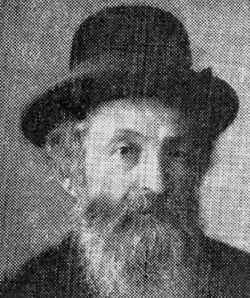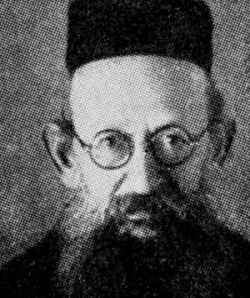 |
 |
|
54°55' N. 23°40'
Zapyskis (Sapizishok in Yiddish) is situated on the left bank of the Neman (Nemunas) River, about fourteen kilometers west of Kovno. The town is first mentioned in historical documents from the end of the sixteenth century.
Until 1795 Sapizishok was included in the Polish-Lithuanian Kingdom. According to the third division of Poland the same year by the three superpowers of those times, Russia, Prussia and Austria, Lithuania was divided between Russia and Prussia. The part of Lithuania on the left bank of the Neman River and including Zapyskis was handed over to Prussia. During the period of Prussian rule (1795-1807) decreased commerce with Kovno, which at that time was under Russian control, caused the economic decline of the town. A statistical document of that time describes Sapizishok as a poor village with 150 residents.
From 1807 to 1815 Sapizishok was under the auspices of the Great Dukedom of Warsaw and was considered a county center in the Bialystok District. In 1813, after the defeat of Napoleon, all of Lithuania was annexed to Russia, and Sapizishok was included in the Augustowa province (Gubernia). In 1866 it became part of the Suwalk Gubernia.
Russian rule brought a revival of trade and occasional fairs were organized in Sapizishok. In 1825 Sapizishok acquired the Magdeburg rights to call itself a town. The flood of 1864 and later World War I caused significant damage to Sapizishok. During the period of Independent Lithuania (1918-1940) Sapizishok was a county administrative center.
Jews probably began to settle in Sapizishok at the beginning of the nineteenth century. It is known that Sapizishok Jews took part in the 1831 rebellion against the Czar. Jews made their living in timber trade and transporting logs along the Neman River. They were village folk, and like their neighbors they would react to injustice with fists. At the same time they had warm Jewish hearts and open minds towards charity issues. The welfare societies Gemiluth Hesed and Linath HaTsedek were very active, and the town had many educated people, among them many subscribers to Hebrew newspapers.
A Hebrew school opened in 1910 and continued to offer education through the times of Independent Lithuania. Students of different ages studied in one room and with one teacher.
Following the passage of the Law of Autonomies for Minorities issued by the new Lithuanian government in 1918, the Minister for Jewish Affairs, Dr. Menachem (Max) Soloveitshik, ordered elections to community committees (Va'adei Kehilah) to be held in the summer of 1919. In 1919 a Va'ad (community committee) with five members was elected in Sapizishok: two from the Tseirei Zion list, two unaffiliated and one from the General Zionists. The committee was active in all fields of Jewish life until the end of 1925. Of 97 people with voting rights, only 75 voted.
According to the first government census in 1923, the population of the town reached 589, of whom 293 were Jews (50%).
During that period Sapizishok Jews made their living in the small trades, timber and crafts. Jewish people owned the flourmill and the sawmill.
In 1937 fifteen Jewish tradesmen worked in the town: seven butchers, three shoemakers, two glaziers, one baker, one tinsmith and one photographer. In 1939 there were twenty telephone subscribers; only two were Jewish.
Among Sapizishok Jews a Zionist atmosphere prevailed and there were supporters of almost all of the Zionist parties. The Zionists purchased Shekalim and voted for the Zionist Congresses, as seen in the table below:
| Congress No. |
Year | Total Shkalim |
Total Votes | Labor Party
|
Revisionists | General Zionists
|
Grosmanists | Mizrakhi | ||||||
| 16 | 1929 | 18 | — | — | — | — | — | — | — | — | ||||
| 18 | 1933 | — | 17 | 16 | — | — | — | — | 1 | |||||
| 19 | 1935 | — | 105 | 56 | — | 1 | 2 | 40 | 6 | |||||
Sport activities were run by the local Maccabi Branch with 26 members in the 1920s.
Religious life centered on the local synagogue. The rabbis who served in Sapizishok during those years were:
Yisrael Avigdor
Hayim Ze'ev Kriger (?-1903)
Aharon-Shelomoh Zalmanovitz
Meir Verzhbolovsky (1881-1941), published many books on religious issues, was murdered in the Shoah.
Yohanan Zarkhi (Zupovitz) (1874-1946), was active in the Mizrahi party and in the National Funds, emigrated to Eretz-Yisrael in 1934 and became a rabbi in Tiberias. He was well liked by farmers in the agricultural settlements in the Jordan valley, and died in Tiberias.
Yits'hak Grin (1880-1941), the last Rabbi of Sapizishok, murdered in the Shoah.
|
|
|||
Among the personages born in this town were Dr. Mosheh Kriger, director of the Hospital in Zefat and deputy chairman of the Medical Association in Israel, and the well-known artist Yehezkel Shtraikhman (died in 1993 in Tel Aviv).
In the summer of 1940 Lithuania was annexed to the Soviet Union and became a Soviet Republic. Following new regulations, many Jewish businesses were nationalized. All Zionist parties and youth organizations were disbanded, the Hebrew school was closed and a Yiddish school was opened instead. Supply of goods decreased, and as a result, prices soared. The middle class, mostly Jewish, bore the brunt, and the standard of living dropped gradually.
Several days after the German invasion of the Soviet Union on June 22, 1941, the German army entered Sapizishok. The Lithuanian nationalists, who took control, began to victimize and rob the Jews.
On August 7, 1941, Jews were forced out of their homes and their property looted while they were detained in a ghetto. In the middle of August Lithuanian police took forty young men from the ghetto to a place next to the Jewish cemetery, where they were murdered and buried. On September 4, 1941 (12th of Elul, 5701) the remaining men, women and children were led to the bank of the Neman River, near the neighboring villages of Dievogaila and Kluoniskiai where they were murdered and buried in a mass grave. According to German sources 47 men, 118 women and 13 children were murdered at that location.
|
|
| The monument near the mass grave: the inscription in Hebrew and Lithuanian states, “In this place in 1941 the Hitlerist murderers and their local helpers murdered approximately 282 Jews, children, women and men.” |
|
|
| The mass grave near the village of Dievogaila |
Sources:
YIVO, New York, Collection of Lithuanian Jewish Communities, files 670-672
Di Yiddishe Shtime, Kovno, 1.10.1919
Teviskes Zinios, Kaunas, 6.4.1991
The above article is an excerpt from “Protecting Our Litvak Heritage” by Josef Rosin. The book contains this article along with many others, plus an extensive description of the Litvak Jewish community in Lithuania that provides an excellent context to understand the above article. Click here to see where to obtain the book.
|
JewishGen, Inc. makes no representations regarding the accuracy of the translation.The reader may wish to refer to the original material for verification.
JewishGen is not responsible for inaccuracies or omissions in the original work and cannot rewrite or edit the text to correct inaccuracies and/or omissions.
Our mission is to produce a translation of the original work and we cannot verify the accuracy of statements or alter facts cited.
 Protecting Our Litvak Heritage
Protecting Our Litvak Heritage
 Yizkor Book Project
Yizkor Book Project
 JewishGen Home Page
JewishGen Home Page
Copyright © 1999-2026 by JewishGen, Inc.
Updated 17 Jan 2012 by JH